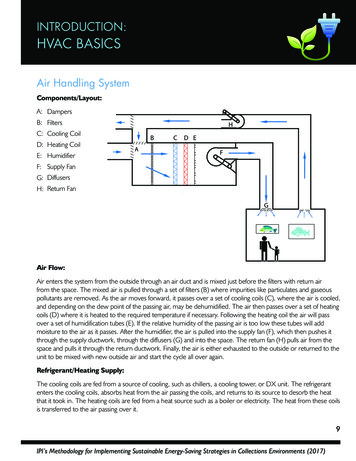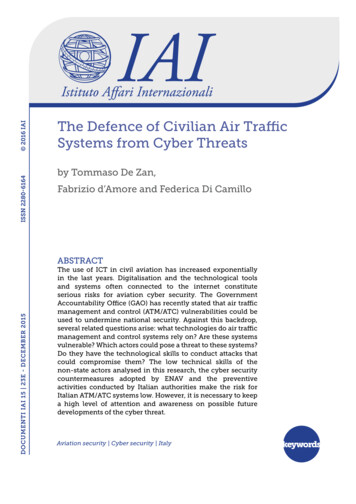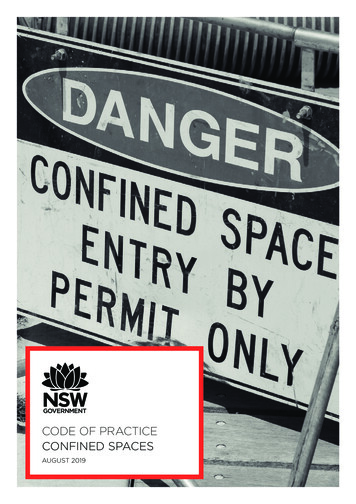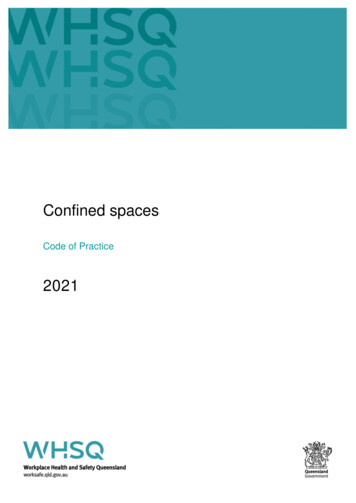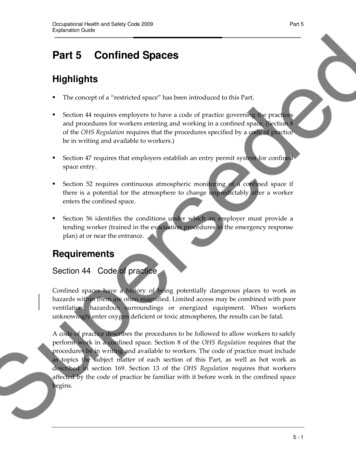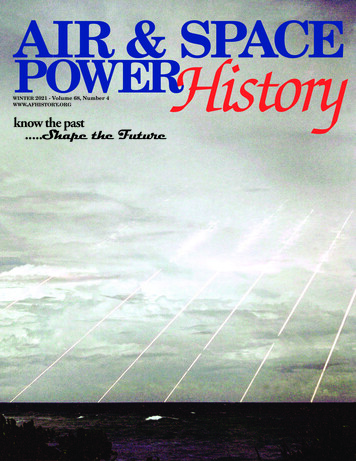
Transcription
AIR & SPACEHistoryPOWERWINTER 2021 - Volume 68, Number 4WWW.AFHISTORY.ORGknow the past.Shape the Future
Winter 2021 - Volume 68, Number 4WWW.AFHISTORY.ORGknow the past.Shape the FutureFeaturesBook ReviewsDepartmentsJoint Task Force Proven Force and the Gulf War (Part 1)Theo van GeffenDid We Hit the Target?: A Brief History of Missile Impact LocationSystems 1959-2020David K. StumpfRobert Manning GrayMervyn RobertsImages of War: The Hawker HunterBy Martin W. BowmanReview by Daniel J. SimonsenRocky Boyer’s War: An Unvarnished History of the Air Blitz that Won the War in the Southwest PacificBy Allen D. BoyerReview by Steven D. EllisThe Tonkin Gulf Yacht Club: Naval Aviation in the Vietnam WarBy Thomas McKelvey CleaverReview by Ernest SnowdenThe Secret Horsepower Race: Western Front Fighter Engine DevelopmentBy Calum E. DouglasReview by Tony KambicLuftwaffe Special Weapons: 1942-45By Robert ForsythReview by Gary ConnorThe Bomber Mafia: A Dream, A Temptation, and the Longest Night of the Second World WarBy Malcom GladwellReview by Steve AgoratusStorms over the Mekong: Major Battles of the Vietnam WarBy William HeadReview by John CiraficiAbove the Reich: Deadly Dogfights, Blistering Bombing Raids, and other War Stories from the.By Colin Heaton & Anne-Marie LewisReview by Gary ConnorThe Tornado Years: More Adventures of a Cold War Fast-Jet NavigatorBy David HerriotReview by Edward M. YoungWorld War II Fighter Planes Spotter’s GuideBy Tony Holmes.Review by Scott M. WilleyArado Flugzeugwerke: Aircraft and Development HistoryBy Volker KoosReview by Gary ConnorThe Schneider Trophy Air Races: The Development of Flight from 1909 to the SpitfireBy Jerry MurlandReview by Jon BarrettAir Marshall Sir Keith Park: Victor of the Battle of Britain, Defender of MaltaBy Murray RowlandsReview by Steven D. EllisWith His Hand: The Incredible Story of John C. “Red” MorganBy Daniel SimmonsReview by Steven AgoratusMoral Imperative: 1972, Combat Rescue, and the End of America’s War in VietnamBy Darrel D. WhitcombReview by Dennis H. BergerBritish Fighter Aircraft in World War I: Design, Construction, and InnovationBy Mark WilkinsReview by Scott A. WilleyDien Bien Phu 1954: The French Defeat that Lured America into VietnamBy Martin Windrow & Peter DennisReview by John CiraficiRain of Steel: Mitscher’s Task Force 58, Ugaki’s Thunder-Gods, and the Kamikaze Warr off OkinawaBy Steven L. MooreReview by Edward M. YoungNemoto’s Travels: The Illustrated Saga of a Japanese Floatplane Pilot in the First Year of the Pacific WarBy Michael John ClaringbouldReview by Steven D. EllisMiGs in the Middle East: Soviet-Designed Combat Aircraft in Egypt, Iraq, and Syria, Vol. 1 1955-1963 &MiGs in the Middle East: Soviet-Designed Combat Aircraft in Egypt and Syria, Vol. 2 1963-1967By David Nicolle & Tom CooperReview by Steven D. EllisBy Bill NortonReview by Golda EldridgePresident’s MessageReference AssistanceUpcoming EventsHistory MysteryCOVER: LGM-118A Peacekeeper missile system being tested at the Kwajalein Atoll in the Marshall 060663616264
The Air Force Historical FoundationThe Journal of theAir Force Historical FoundationWinter 2021 Volume 68 Number 4EditorRichard I. WolfEditor EmeritusJacob NeufeldAir Force Historical FoundationP.O. Box 790Clinton, MD 20735-0790(301) 736-1959E-mail: angelabear@afhistory.orgOn the Web at http://www.afhistory.orgBoard of DirectorsGen James M. “Mike” Holmes, USAF (Ret.)ChairmanMs. Jonna Doolittle Hoppes, PresidentLt Gen Nicholas B. Kehoe, USAF (Ret.)First Vice ChairmanDr. Rebecca Grant, SecretaryCol Stephen E. Newbold, USAF (Ret.)TreasurerCol Christopher J. Brunner, USAF (Ret.)Lt Joseph Burke, USAFR (Ret.)Gen Ralph E. Eberhart, USAF (Ret.)Lt Gen Robert J. Elder, USAF (Ret.)Lt Gen Charles R. Heflebower, USAF (Ret.)Maj Gen Paul T. Johnson, USAF (Ret.)Maj Gen Charles W. Lyon, USAF (Ret.)Brig Gen Patrick C. Malackowski, USAF (Ret.)Dr Richard I. WolfEmeritusMaj Gen Dale W. Meyerrose, USAF (Ret.)ChairmanEditor, Air Power HistoryRichard I. WolfEditor Emeritus, Air Power HistoryJacob NeufeldStaffLt Col James A. Vertenten, USAF (Ret.)Secretary to the Board andExecutive DirectorMrs. Angela J. Bear, Office ManagerPresident’s CircleLt Col Kenneth W. Sublett, USAF (Ret.)Book Review EditorScott A. WilleyAdvertisingJim VertentenCirculationAngela J. BearBenefactorGen James P. McCarthy, USAF (Ret.)Patron MembersCol Terry Balven, USAF (Ret.)Col Christopher Brunner, USAF (Ret.)Mr. Darrell DvorakDr. John FarquharLt Col Raymond Fredette, USAF (Ret.)Dr. Jerome V. MartinBrig Gen William L. Shields, USAF (Ret.)Brig Gen Wade R. SmithDonationsEileen BjorkmanDr. John FarquharLt Gen Charles R. Heflebower, USAF (Ret.)Gen James P. McCarthy, USAF (Ret.)Lt Gen Christopher D. Miller, USAF (Ret.)Sherman MullinLt Gen Michael A. Nelson, USAF (Ret.)Curtis L. WeilEdward YoungCorporate SponsorsBoeingCalvert SystemsGeneral AtomicsGeneral Electric AviationLeidosLockheed MartinL3Harris TechnologiesNorthrop GrummanPratt & WhitneyWings over the Rockies Air MuseumAir & Space Power History (ISSN 1044016X) is produced for Spring, Summer, Fall, andWinter by the Air Force Historical Foundation.Prospective contributors should consult theGUIDELINES FOR CONTRIBUTORS atthe back of this journal. Unsolicited manuscripts will be returned only on specific request. The Editor cannot accept responsibilityfor any damage to or loss of the manuscript.The Editor reserves the right to edit manuscripts and letters.Address LETTERS and manuscripts to:Air & Space Power History148 Bay DriveSudbury, MA 01776e-mail: airpowerhistory@yahoo.comCorrespondence regarding missed issues orchanges of address should be addressed tothe CIRCULATION OFFICE:Air & Space Power HistoryP.O. Box 790Clinton, MD 20735-0790(301) 736-1959e-mail: angelabear@afhistory.orgADVERTISINGJim VertentenP.O. Box 790Clinton, MD 20735-0790(301) 736-1959e-mail: ed@afhistory.orgCopyright 2021 by the Air Force HistoricalFoundation. All rights reserved.Periodicals postage paid at Clinton, MD20735 and additional mailing offices.Postmaster: Please send change of addressto the Circulation Office.2AIR & SPACE POWERHistory / WINTER 2021
President’s MessageDear Foundation Members and Friends,It is a great honor to serve as the President of the Air Force Historical Foundation and agreat comfort to share leadership with our Chairman, General Holmes. The last two yearshave been challenging for the foundation and the Nation, but they allowed us to look backover our achievements as an organization and adjust our focus on the future.When General Spaatz and a handful of other air power pioneers founded the Air ForceHistorical Foundation, it was dedicated to “preserving the history and traditions of Americanaviation, with emphasis on the U.S. Air Force, its predecessor organizations, and the men andwomen whose lives and dreams were devoted to flight.”As General Holmes and I attempt to temporarily fill those pioneers’ very big shoes, wewill focus on expanding our founders’ vision, not only to include our new Space Force, but torededicate our energy into making the Air Force Historical Foundation more responsive toand inclusive of future generations. Our goal is to make sure Air Force and Space Force historyis collected, preserved and available to anyone who wants to learn more about our sharedheritage. The Air Forces’ 75th Anniversary provides an opportunity and a framework for continuing this process.We believe that creating a more interactive website with expanded searchable archives isa good place to start. With that in mind, we are working on multiple projects to digitize original material from great Air Force and Space Force leaders, as well as projects to capture oralhistories from current active duty and Reserve members of both services. We hope to beginwith Project 9/12, a series of recorded interviews with Airmen and Guardians beginning withSeptember 11, 2001, and continuing through the end of the twenty-year war in Afghanistan.We know that multiple organizations have dedicated themselves to collecting air and spacepower history and that they’ve done a great job. Since our goal is to make sure history isavailable to all, we are starting a pilot program to partner with air and space museumsaround the country. General Barry, one of our board members, has agreed to lead this mission.We plan to participate in various museum events and to provide descriptions of the museums,their collections, and the focus of their research on our website with links to their websites.Another project under construction is the development of a virtual book group. We plan topost a list of recommended books and to host an interactive, online book discussion with authors, experts and historians. Perhaps we’ll start with our own book, 75 Great Airmen, by Dr.Rebecca Grant, the foundation’s tribute to the 75th Anniversary of the Air Force.In the meantime, Air and Space Power History will continue to focus on scholarly studiesof air and space power—what happened, what worked, what didn’t work and why.Our Awards Dinner, originally scheduled last October, has been rescheduled to Monday,May 2, 2022. Please watch for more information. We look forward to hosting our recipientsand celebrating their achievements with all of you. This year we are honoring General JohnW Raymond, USSF, with the Spaatz Award, Dr. Daniel Haulman with the Holley Award, the28th Bomb Wing with the Doolittle Award, Dr. Brent D Ziarnick will receive the Best BookAward and Col. Jason A. Altieri the Best Article Award.AIR & SPACE POWERHistory / WINTER 20213
As General Holmes and I begin our term, we want to let you know how important you areto the Air Force Historical Foundation. We want to make these next few years a joint journeywith you as our partners. We plan to listen to your suggestions and include you as we moveforward. That said, we have a request. We would like our members to become more active inthe foundation by starting with participating in the nomination process for our 2022 awardrecipients. Please let us know who you think we should honor and why.In closing, we would like to thank you for this opportunity and for all you’ve done to supportthis historic foundation. I’m sure General Spaatz and that handful of air power pioneers arelooking down and smiling.Respectfully,Jonna Doolittle Hoppes,PresidentFrom the EditorOur issue this time seems to be covering a broad spectrum of Air and Space History. ThePresident’s Message has some insight into future plans.Our first article is by many-time contributor Theo van Geffen.This time he turns his attention to Desert Storm, as he writes about Joint Task Force—Proven Force. Very interestingread and some interesting numbers.Our second article is by much-published missile author David K. Stumpf, who this timeis writing about a small corner of missile development, the ability to measure the accuracyof missile systems. Take a look at it, it’s very comprehensive.Our third article is the story of Robert Manning Gray, a Doolittle Raider who survivedthe raid, but not World War II. Enjoy it. Don’t skip over it to get to the reviews of which thereare 20 this time.The President’s Message begins on page 3. Don’t miss Upcoming Events on page 62, although I fear you must continue to take all dates in that section as still uncertain at thispoint. If you see something scheduled, be sure to check with the organization sponsoringthe event to ensure it will take place. And the closing story is this issue’s Mystery. Enjoy!Air & Space Power History and the Air Force Historical Foundation disclaim responsibility for statements, either offact or of opinion, made by contributors. The submission of an article, book review, or other communication with theintention that it be published in this journal shall be construed as prima facie evidence that the contributor willinglytransfers the copyright to Air & Soace Power History and the Air Force Historical Foundation, which will, however,freely grant authors the right to reprint their own works, if published in the authors’ own works.4AIR & SPACE POWERHistory / WINTER 2021
Joint Task ForceProven Force andthe Gulf War(Part 1)The first fighter aircraft to arrive in the Gulf Region, on August 8 at Dhahran (Saudi Arabia), were the twenty-four F–15C Eagles of the 71st TFS (1st TFW, Langley). The aircraftare configured with four AIM-9s and four AIM-120 AMRAAMs.The personnel are members of the Security Police. (USAF)STheo van Geffentarting in August 1990, U.S. and allied forces arrived in numbers in the Gulf region to persuade Iraq’s SaddamHussein to give up Kuwait, which was occupied on August 2, and claimed as Iraq’s 19th province. In mid-January,a second front was opened from Incirlik Air Base (Turkey). A score of aircraft types were involved. In a multi-partarticle we will have a closer look at the involvement of several aircraft types, including the B–52G Stratofortress and F–4G Phantom. This part will discuss the ‘birth’ of Joint Task Force PROVEN FORCE (JTF-PF) and B–52G operations.Air campaignThe first USAF aircraft to arrive in the Gulf region, on August 8 at Riyadh, were five E–3A/B Airborne Warning andControl System (AWACS) aircraft from Tinker’s 552nd Airborne Warning and Control Wing (AWCW). They did so priorto the arrival in the afternoon from Langley AFB, Virginia, of twenty-four F–15Cs of the 71st TFS/1st TFW at Dhahran(Saudi Arabia). The Squadron immediately started to augment Royal Saudi Air Force (RSAF) air defense alert and CAP(Combat Air Patrol) operations. Also on the 8th, Great Britain committed itself, with the first Tornado F.Mk 3s arrivingfrom Cyprus at Dhahran on August 11. The number of USAF aircraft in-theater on November 1 was 718 (Phase I), including 20/B–52G, 36/F–4G and 14/EF–111A. F–16s topped the list with 120 deployed.January 15, 1991 was the deadline the United Nations Security Council had agreed upon earlier to expel Iraqi troopsfrom Kuwait using force when the country would still be occupied. By then, the number of USAF aircraft had increasedto 1,132 (Phase II). With 210 aircraft, F–16s once more topped the list. The number of B–52Gs had increased to twentyone, the F–4G number was forty-eight and of the EF–111A, eighteen.NormandyOn January 16, the DESERT STORM air campaign plan was completed with an Air Tasking Order (ATO) issued foreach 24-hour period, 0300-0259Z (0600-0559L). However, the period for the Day 1 ATO was 16/1800Z-18/0700Z Jan. Theair war began with two days of pre-planned operations, which were the most thoroughly planned and most complex airoperations of the war.H-hour was 17/0300L Jan. At H-90 (0130L) January 17 (16/2230Z Jan), Navy ships in the Persian Gulf and Red Seastarted launching fifty-two BGM–109 Tomahawk cruise missiles towards targets in Baghdad, of which about one-thirdAIR & SPACE POWERHistory / WINTER 20215
At H-21 (0239L), twenty-one minutes prior to the start of DESERT STORM,Task Force NORMANDY was on their way to their targets in Iraq. It includedfour MH–53J PAVE LOW III helicopters, acting as pathfinders for eight USArmy AH–64A Apache attack helicopters. An MC–130E was airborne astanker support, while MH–47Ds were available with FARRP equipment to refuel the Apaches when necessary. Both sites were destroyed with AGM-114Hellfire missiles, Hydra 70 rockets and the Apache's 30-mm gun. (USAF)against the electrical power grid. Their Time-on-Targets(TOTs) was 0306-0311L. At H-21 (0239L), Task ForceNORMANDY, four MH–53J PAVE LOW III helicopters(20th Special Operations Squadron (SOS)/1st Special Operations Wing [SOW, Hurlburt]) acted as pathfinders foreight U.S. Army AH–64A Apache attack helicopters (1stBattalion/101st Aviation Regiment [Ft Campbell, KY]) totheir targets in Iraq, two Early Warning (EW) radar sitesabout fifty nautical miles (NM) north and north northeastof Ar’Ar. The MH–53J’s FLIR (Forward-Looking Infrared)and TFR (Terrain-Following Radar) permitted safe flightat extremely low altitudes at night, with GPS (Global Positioning System) permitting precise navigation. The firstrehearsal for the mission, initially called EAGER ANVIL,was flown in the second week of October. Five rehearsalsfollowed. The joint briefing at Al Jouf, Saudi Arabia tookplace at 2130L. The border was crossed at 0212L. An MC–130E of the 9th SOS (also 1st SOW) was airborne as tankersupport, while MH–47Ds of the 3rd Battalion/160th Special Operations Aviation Regiment (SOAR) were availableTheo van Geffen has been an aviation journalist and historian since 1977. He is from Utrecht, The Netherlands.His focus is the history of the F–105 Thunderchief andthe units it was assigned to, and of the Air War in Southeast Asia. Mr. van Geffen has flown in USAF aircraft likethe B–1B Lancer, EC–130E ABCCC, Century fighters F–101B Voodoo, F–105F, and F–106B Delta Dart, F–15B/DEagle and the F–16B Fighting Falcon. He was the firstprogram speaker at the THUD-OUT at Hill AFB on February 25, 1984 and one week later he became the last F–105 back seater ever while flying the next to last flyableF–105F to Little Rock AFB.6with FARRP (Forward Area Refueling and RearmingPoint) equipment to refuel the Apaches when necessary.Both sites were destroyed with AGM-114 Hellfire missiles,Hydra 70 rockets and the Apache’s 30-mm gun. The resultwas the creation of a ‘hole’ in Iraq’s electronic warfare coverage for the strike package, including, among others,twenty-two F–15E Strike Eagles and three EF–111As,which were fragged for the western Scud sites around H-2and H-3 airfields. For the same purpose and at H-9(0251L), an F–117A of the 37th TFW (all F–117A strikeswere flown by single aircraft) dropped the first bomb of thewar, a GBU-27 PAVEWAY III 2,000-lb penetrating LGB(Laser-Guided Bomb), striking the Nukhayb Intercept Operations Center. It was the central reporting node in southern Iraq and best positioned to coordinate Iraqi defensiveefforts against succeeding allied SEAD (Suppression ofEnemy Air Defenses) attacks by F–4Gs. Capt Marcel Kerdavid, Weapons Officer for the 415th TFS and F–117Apilot,That first target was hit by two F–117s one minute apart.At 0300L, we hit Baghdad targets simultaneously with fiveF–117s, followed by two aircraft one minute later, also simultaneously, but with a different DMPI, Desired MeanPoint of Impact. My target was the Khark Telecommunications Tower in downtown Baghdad. It required a laser spoton a latticed tower and I took that challenge. Original planwas to drop a 2,000-lb GBU-10 PAVEWAY II, but my #2 engine would not start on my scheduled aircraft, so I went toa spare, which was configured with a GBU-27. The GBU10 was fused to blow the top off the tower. The fuse on theGBU-27 could not be changed as it was meant to be a penetrator. Luckily after entering the top of the tower it apparently did not have the energy to exit, which I feared it would,and it blew up halfway down the tower.In the meantime, seven Barksdale B–52G aircrewshad launched thirty-five CALCMs (Conventional AirLaunched Cruise Missiles) from two launch points in SaudiArabia (see later). Also, four F–111Fs of Tactical FighterWing Provisional, 48 (TFWP 48) struck the heavily defended airfield Ali Al Salem, ingressing to the target areaat low altitude and high speed in the darkness of night.BQM-74 drones were launched from just south of the Iraqiborder towards Baghdad to decoy radars, create confusionand false targets to enhance F–4G Wild Weasel targeting.Fixed-wing Coalition aircraft flew 2,759 sorties, including1,515 by USAF aircraft. B–52Gs flew thirty-one sorties (see‘Day 1’).SuspensionG-day started at 0400L on February 24 with 100,000Coalition troops initiating the ground war, which turnedout to become a 100-hour campaign. A total of 3,280 coalition sorties were flown that day, the largest number todate. Forty-three B–52Gs struck Iraqi defenses and infantry positions in the KTO (Kuwait Theater of Operations). Because of the rapid advance of ground troops intoAIR & SPACE POWERHistory / WINTER 2021
Kuwait and Iraq, retargeting of preplanned Close Air Support (CAS) and BAI (Battlefield Air Interdiction) sortieswas required, including of inbound B–52s. On February 27,Kuwait City was liberated and Pres Bush ordered the suspension of offensive military operations as of midnighteastern time. As a result, on 28/0800L, a Coalition-declaredceasefire went into effect. Sixteen days later, redeploymentof 545,000 U.S. troops was initiated. Iraq, on April 11, accepted all terms of the UN cease-fire resolution and at 1000EST, the Gulf War officially ended.In the forty-three days of the war, Coalition forces flew118,661 sorties with the USAF share being 69,406 sorties.Of note is that A–10As and F–111Fs flew more than doublethe peacetime UTE. Because of the long CAP missions, inwhich 8-hour sorties were not uncommon, F–15C Eaglesflew an Average Sortie Duration (ASD), which was 3.5times the peacetime average.B–52G StratofortressAccording to the USAF, the role of the B–52 in the GulfWar was revalidated, with only the G-model being involvedin DESERT SHIELD/STORM and PROVEN FORCE. Thefirst of 193 B–52Gs built was delivered to Strategic AirCommand (SAC) in February 1959.Ninety-eight on-line Gs were modified to carry twelvenuclear AGM-86B ALCMs each. The thirty-nine nonALCM modified B–52Gs received the ICSMS, IntegratedConventional Stores Management System, and were assigned the primary role of supporting the conventional requirements of theater commanders and naval anti-surfacewarfare operations. On September 30, 1990, the USAF had135 B–52Gs. To abide to the terms of the Strategic ArmsReduction Treaty (START), the first B–52G was retired onMay 11, 1989 and arrived at the Aerospace Maintenanceand Regeneration Center (AMARC) at Davis-Monthan,Arizona to be salvaged. In the first 3½ months of 1991 noB–52Gs were retired.From the start of DESERT SHIELD, SAC underscoredthe need to have forward basing. The first discussion to deploy B–52Gs to Southwest Asia was when CINCCENT(Commander in Chief, Central Command), through message 08/0330Z Aug 90 to the Joint Chiefs of Staff (JCS) ‘Follow-on Forces Additions’, decreased the number of F–16squadrons requested by JCS 07/2153Z Aug message, fromsix to four, while adding, among others, five B–52Gs. Oneday later, at 09/1345Z Aug, JCS issued further deploymentorders through C 30 (C–Day/L-Hour was designated as09/0001Z Aug), which included twenty-three more B–52Gsto perform conventional operations.On August 24, SAC activated Air Division Provisional, 17 (ADP 17) to organize and administer SAC assets assigned to the Area of Responsibility (AOR). AirForces Central Command (CENTAF) received operationalcontrol of assigned B–52Gs and tactical control of assigned KC–135s and strategic reconnaissance assets. OnSeptember 9, Central Command (CENTCOM) was awaiting basing approval to increase theater B–52G strengthto twenty-eight.AIR & SPACE POWERHistory / WINTER 2021At H-9 (0251L), an F–117A of the 37th TFW dropped the first bomb of theGulf War, a GBU-27 PAVEWAY III 2,000-lb penetrating bomb, striking theNukhayb Intercept Operations Center. The photo shows three of the stealthfighters at their temporary base of Khamis Mushayt (Saudi Arabia). (USAF)When the JCS issued the Phase II deployment orderon November 16, for 283 aircraft, it included eight B–52Gs.Aircraft on-call for deployment within 120 hours of thecommencement of hostilities included another fourteen B–52Gs. On January 11, 1991, at CENTAF direction, SAC accelerated its tanker force commitment to provideCINCCENT with the requested plus-up of B–52Gs andKC–10A/KC–135 tankers and aircrews.Diego GarciaOn August 3, 1990, SAC deployed two KC–10A Extenders and one KC–135R Stratotanker from Hickam AFB,Hawaii and Andersen AFB, Guam to Diego Garcia, a tropical island in the Indian Ocean. A second KC–135R at theisland remained in place. CENTCOM requested twentyeight B–52Gs, with five to deploy to Diego Garcia by the16th, fourteen by August 24, and nine more by September6. In reality, deployments were on August 12 (seven), August 13 (seven) and August 15 (six). Each of the twenty aircraft was configured with forty-five M-117R 750-poundgeneral purpose bombs. As not enough ramp space wasavailable, the final eight requested B–52Gs could not deploy. The twenty aircraft were assigned to 69th Bombardment Squadron, Heavy (BS)/42nd Bombardment Wing,Heavy (BW) from Loring, AFB, Maine (fourteen) and of the62nd BS/2nd BW from Barksdale AFB, Lousiana (six) anddeployed from Andersen where they participated in aGIANT WARRIOR exercise. The squadrons were augmented by a handful of crews from Castle AFB, California(93rd BW) and Griffiss AFB, New York (416th BW). On August 24, nine days after the arrival of the last six aircraft,Bombardment Wing Provisional, 4300 (BMWP 4300) wasdesignated, activated, and organized at Diego Garcia, andattached to 15th Air Force (15AF). On September 21, SACwent through a similar process regarding BombardmentSquadron Provisional, 4300 (BMSP 4300), Air RefuelingSquadron Provisional 4300 (AREFSP 4300) and Consolidated Aircraft Maintenance Squadron (CAMSP 4300) and7
B–52G 58-0164 'SAC Time' of the 668th BS (416th BW, Griffiss) sits ready at Jeddah on February 1 for its next combat sortie. The BMWP 1708 aircraft isconfigured with M-117 750-pound bombs and already flew twenty-five combat sorties. (PH3 Chester Falkenhainer)assigned the Squadrons to the Wing. On February 1, theWing possessed 19/B–52G, 7/KC–10A and 5/KC–135R. Effective June 3, the Wing was the last provisional B–52Gunit to be inactivated.of combat-ready aircraft remained at twenty. The swap-outalso enabled the munitions resupply on Diego Garcia.Twenty-eight B–52G phase inspections were accomplishedat Andersen, 122 engine changes and sixty BUFFs underwent wash and corrosion control.SizeableTrainingOn 31/2115Z Aug 90, 219 allied aircraft were on fiveminute-one hour day/night alert, including seven B–52Gsat Diego Garcia. On September 14, SAC stated that fourteen B–52Gs at Diego Garcia were on alert, loaded withCBUs or M-117 bombs. Also, that of its deployed 186tankers, thirteen were at the island.The number of BUFFs (Big Ugly Fat Fellows) in BMSP4300 remained stable throughout the campaign. On January 16, 1991 the Squadron gained six aircraft which arrived from Andersen’s Strategic Wing Provisional, 1500(SWP 1500), but lost a similar number the next day whenthe aircraft launched on a combat mission and landed atJeddah (New). The 1500th in turn received six B–52Hsfrom CONUS.It was not surprising that the Diego Garcia BUFFsflew a sizeable number of flying hours. It was not possibleto accomplish intermediate-level maintenance and heavymaintenance like corrosion washes, engine changes andphase inspections there (it had been discussed, but wasnever materialized) and for this reason Wing B–52Gs hadto be flown to Andersen where an Intermediate LevelMaintenance Center (ILMC) was established. After SWP1500 had received four spares by August 22, it became possible to regularly rotate B–52Gs between the two bases toprovide, for example, corrosion control treatment. However,an Andersen B–52G was to land at Diego Garcia before itsB–52G could launch for Andersen. In this way, the number8The aircrews and maintainers were experienced atconventional operations from deployed locations as theyhad been trained mostly on a conventional war in Europe.However, they lacked the specific expertise necessary inSouthwest Asia. This made it necessary to set up a specialtraining program, to be conducted some 3,000 miles fromthe AOR. To do this properly, access to the Arabian Peninsula and integration into CENTAF’s Airspace Management System were required. On August 20, Saudi Arabiaauthorized B–52 training. The next day, two B–52Gs flewtraining missions in the AOR. The aircrews gained a basicorientation of the terrain characteristics and regionalcommunication procedures, including coordination withE-3 AWACS aircraft. Through September 16, sixteen suchtraining sorties were flown, of which eight night low-levelsorties on the 16th, while eleven were flown at Diego Garcia. Thereafter, due to the long sorties and the scarcity ofresources on the island, training involved only a low number of sorties per month. Mission profiles and routes weredeveloped to provide navigation and packaged fighter operations to maximize efficiency. Two distinct training profiles eventually emerged, one to a local island and oneover the Arabian Peninsula. The latter provided the mostrealistic training, which included, cell takeoff, low-level,heavyweight air refueling, bombing and ElectronicCounter- Measures (ECM). Examples were the trainingAIR & SPACE POWERHistory / WINTER 2021
mission on September 23, when five B–52Gs flew a lowlevel strike mission, supported by F–4Gs providing defense suppression and on October 25, exercise INITIALHACK, a night strike by a combined package againstthree airfields of twenty-seven aircraft, including two B–52Gs, two F–117As, two F–4Gs and six Saudi and eightRAF Tornados.The island profile was much shorter in duration andincluded cell takeoff, departure and join-up, simulatedbombing runs and touch and go landings. The formal resultwas the development into an Initial Mission QualificationTraining (IMQT) program. After CINCSAC, General JohnT. Chain, had stated he wanted an increase in the frequency of training missions into the AOR, his Director ofOperations directed in November that the tempo of training be increased for each bomber crew. As of December 20,Wing B–52Gs had flown 418 DESERT SHIELD sorties for4,020 hours. On January 15, 1991, all training sorties werediscontinued.As SAC was still looking at increasing the number ofB–52G Forward Operating Locations (FOLs), the Command and its 15AF recognized that B–52G aircrews hadto be trained in CONUS prior to deploying. In October,15AF proposed a series of exercises to simulate the combatsitua
Col Christopher Brunner, USAF (Ret.) Mr. Darrell Dvorak Dr. John Farquhar Lt Col Raymond Fredette, USAF (Ret.) Dr. Jerome V. Martin Brig Gen William L. Shields, USAF (Ret.) Brig Gen Wade R. Smith Donations Eileen Bjorkman Dr. John Farquhar Lt Gen Charles R. Heflebower, USAF (Ret.) Gen James P. McCarthy, USAF

